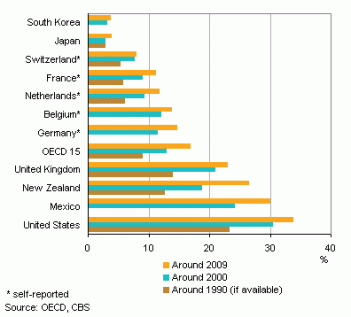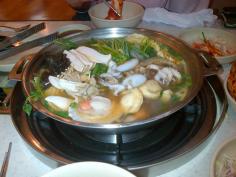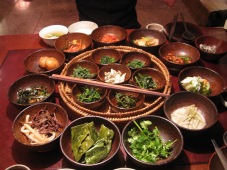
cbs.nl
Korea is known for having low obesity levels, with only an estimated 4% of people being obese, much lower than the 35% of Americans, or 25% of Brits. It’s true that the percentage of overweight Koreans is increasing, but nowhere near as drastically as other Western countries. And I don’t find the trend at all surprising; In fact, I’ve found it a lot easier to maintain a healthy-eating lifestyle since living in Korea.
While it may be true that if I lived in Seoul, I’d be a lot more tempted by unhealthy foods due to the abundance of Western cafes and restaurants, as it is where I live in Wonju, the majority of food places are Korean and therefore offer much healthier menus. Eating out at restaurants, which in England would lead to large calorie-and-fat laden meals, can be just as healthy an option as eating at home because there is always a healthy choice on the menu.
That’s not to say that the unhealthy alternatives aren’t there to choose from; you can still find fried chicken, huge fried donkas, or greasy fried rice, which obviously aren’t as good for your waistline. But, as a whole, Korean food is decidedly more guilt-free than Western food. And luckily, it also happens to be tasty and delicious!
Here are some of the reasons which it’s easier to stay safely on the healthy wagon in Korea:
Meals
 The most obvious first- Korean meals. Compared to Western meals from around the world (pizza, hot dogs, burgers, fish-and-chips, pies, curries, mac-and-cheese…), Korean meals are decidedly healthy. Soups and stews filled with vegetables; low-fat noodle or rice based meals; barbecue with salad on the side instead of bread rolls, cheese, mayonnaise and ketchup. Then there’s the fact that rice is always given as the carbohydrate component to the meal, in place of mashed potatoes, roast potatoes or chips.
The most obvious first- Korean meals. Compared to Western meals from around the world (pizza, hot dogs, burgers, fish-and-chips, pies, curries, mac-and-cheese…), Korean meals are decidedly healthy. Soups and stews filled with vegetables; low-fat noodle or rice based meals; barbecue with salad on the side instead of bread rolls, cheese, mayonnaise and ketchup. Then there’s the fact that rice is always given as the carbohydrate component to the meal, in place of mashed potatoes, roast potatoes or chips.
Again, the unhealthy alternative is there if you want to find it, but the vast majority is healthy. Plus, when you eat out, you’re not tempted to order an additional calorific starter or dessert, simply because the option is rarely available. A definite positive if you’re trying to be good whilst dining out.
Vegetables

A lot of the meals are packed-full of vegetables, and if they aren’t you have endless side-dishes: kimchi, radish, seaweed, mushrooms, spinach, bean-sprouts, the list goes on. And they’re varied, so you often get a few different veggies as side dishes; definitely helps you getting your 5-a-day.
Alternatively, choose a main meal packed with veggies: my all-time favourite bibimbap, shabu-shabu where you get a huge plate of greens to add to your soup… There’s no excuse not to eat your veg!
Bakery Items
 I’ve found (to my annoyance at times when I crave a naughty treat) that even sweet bakery items aren’t as calorific, greasy, or fatty as their Western alternatives. Fillings such as red-bean, sweet potato, corn, and fig take the place of things like chocolate. Result? The food is more nutritious and you don’t have to feel guilty at the thought of what you’re eating.
I’ve found (to my annoyance at times when I crave a naughty treat) that even sweet bakery items aren’t as calorific, greasy, or fatty as their Western alternatives. Fillings such as red-bean, sweet potato, corn, and fig take the place of things like chocolate. Result? The food is more nutritious and you don’t have to feel guilty at the thought of what you’re eating.
In England, all of the options are buttery, greasy, and you’d be pushed to find something for under about 500 kcals (I know, I’ve tried). There pretty much isn’t a healthy-option. In Korea, I wouldn’t call bakery foods ‘healthy’, but I also wouldn’t call them ‘sinful’.
(Again, there are worse options to choose from: doughnuts, cream-filled pastries, fried things, but on the whole, they are nowhere near as bad as they could be).
Rice As A Side Dish

Ok, it would be healthier if it was brown rice, but as side-dishes go, it’s definitely better than a load of buttered bread, chips, or fried potatoes. It’s a good, fat free carbohydrate to add to your meal, and far less calorific than the alternatives.
Lack Of Unhealthy Additions To Food

There’s a definite lack of added sauces, dips, or spreads in Korea. Though you can still find them in foods, the use of things like cheese, mayonnaise, ketchup, mustard, or butter is a lot less.
You don’t find sandwiches dripping with butter andmayonnaise as you would in England, cheese is usually only found in Western meals like pizzas or burgers, and gochuchang is the most common sauce to be added to food, in place of ketchup, mayonnaise or mustard.
In general, then, it’s not hard to see why the obesity levels are so much lower in Korea. Meals are more nutritious and packed with goodness, fatty-foods like butter, cheese, mayonnaise are used less, and even snacks are, by comparison to other countries, less detrimental to your diet.
However, there are some mistakes you could make in Korea which could have a negative impact on your diet:
- Fatty meats: Samgyeopsal is the worst offender here. Barbecue is so popular in Korea, and can be so healthy if you eat it right- what can be better than lean, grilled meat alongside some salad? But, if you choose the fatty meats, it is obviously far worse for you. And Samgyeopsal, with more fat than meat, is the worst option you could choose.
- Fast food: A bit of a no-brainer, but true nonetheless. There is so much fast-food on offer in Korea, not only the Western burger chains and pizza places, but the Korean favourite of fried chicken. I know people who eat a lot of this, so much so that my students call chicken an ‘unhealthy’ food, because they’ve only eaten it after it’s been deep fried. Um…
- Instant food (especially ramen): Something which all my students are guilty of, snacking on microwave burgers or instant ramen pots (and for breakfast too, which is just gross). These foods are everywhere and it couldn’t be easier to pop into CU and buy a quick-fix if you’re hungry. But really, these instant meals are unhealthy and completely lacking in nutrients. Not a good option!
- Eating too much (especially rice): Again, fairly obvious, but it’s easy to do. Especially when rice is added as a side to the majority of main meals, even when your main meal is carbohydrate-based. I’ve eaten a ton of noodles before, only to be offered rice as well. Is there any need for the rice? No. Do you eat it anyway? Well, if it’s there… An easy way to add un-needed calories to your meal. The same can be said for asking for more and more side-dishes to go with your meal, Well, if it’s free…
So, if you choose to eat at places like Pizza School, Lotteria, and Baskin-Robbins, buy instant snacks from CU and eat extra rice with every meal, you might not realise how healthily you can eat in Korea, But, I think it’s fair to say that if you avoid the pitfalls, it’s quite easy to eat guilt-free. And if that involves being able to eat out and enjoy delicious meals, that’s definitely a good thing in my opinion.


Recent comments